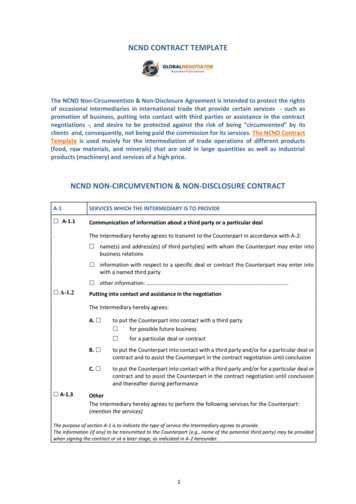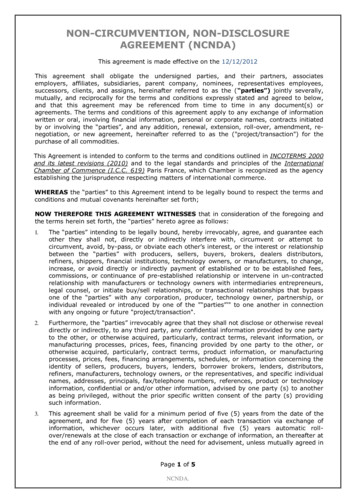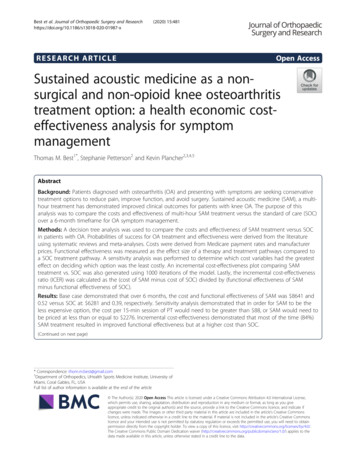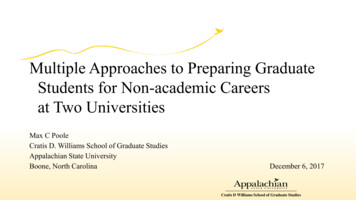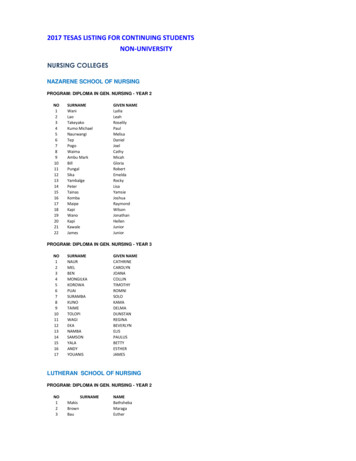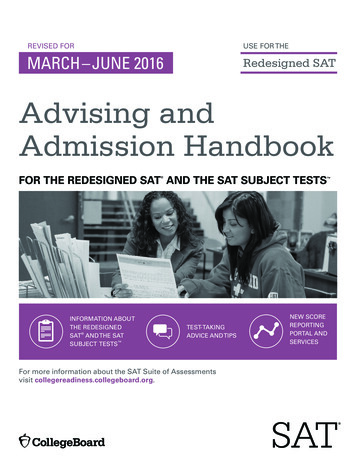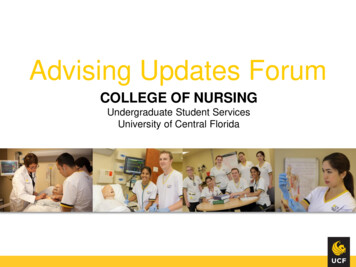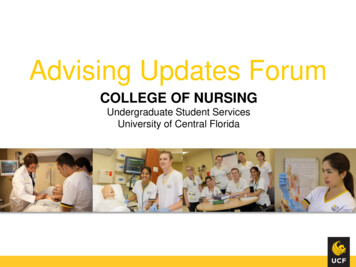
Transcription
In This IssueAdvising Non-Traditional Students:Beyond Class Schedules and DegreeRequirementsPage 1NACADA President Jayne Drake declaresThat’s a WrapPage 2Executive Director Charlie Nutt discussesA Year Filled With Opportunities andChallengesPage 3Raising the Bar: Why is Study Abroad soFundamentally Important?Page 4What Academic Advisors Can Do To BetterServe Students from ChinaPage 4Visa Status and Its Effect on InternationalStudent Academic SuccessPage 5The Importance of Face-to-Face ContactBetween Faculty and Students: UKExample of Pro-active Personal TutoringPage 5Annual Conference Plenary SpeakerRey Junco encourages Using EmergingTechnologies to Engage Students andEnhance Their SuccessPage 6Advising Administration at a Time ofFinancial CrisisPage 7Understanding Arts Training: Beyond“Soft” SkillsPage 82011 NACADA Leadership ElectionInformationPage 92010-12 NACADA Emerging Leaders ClassAnnouncedPage 10Career Corner, SPARKLERs, and muchmorePages 9-20Visitwww.nacada.ksu.edufor more information regarding how theassociation can assist you in providingquality advising on your campus.Advising Non-Traditional Students: Beyond ClassSchedules and Degree RequirementsLorneth Peters, Austin Peay State UniversityMeHee Hyun, Antioch University Los AngelesSylvie Taylor, Antioch University Los AngelesJennifer Varney, Chair, Advising Adult Learners CommissionEditor’s Note: Advisors and advising administratorswho work with non-traditional learners will want toregister for the February 2nd Webinar to be presentedby Advising Adult Learners Commission Chair JenniferVarney and Past-Chair Lisa Peck: Academic Advising forStudent Retention and Persistence: Understanding andAddressing the Needs of Adult Learners. Learn moreabout this event at www.nacada.ksu.edu/Webinars/W37.htm.At one time the term “non-traditional student” referredto a small number of older adults who registeredfor night classes and occasionally asked for advising.Today, the academy has broadened the definitionfor non-traditional student, and we have reassessedtheir needs. The National Center for EducationalStatistics (2002) reported that at least 73 percent ofundergraduates have at least one “non-traditional”characteristic: not enrolling in college immediatelyafter high school graduation, working full-time, beingfinancially independent, having dependents, being asingle parent, or not possessing a high school diploma.Non-traditional students also are disproportionately firstgeneration and students of color.Unlike many traditional students who were raisedwith college completion as a primary goal, thesenon-traditional learners may not have viewed highereducation as a part of their development or life trajectory.Non-traditional students often enroll in college duringa period of transition, e.g., during a divorce, changein job/career, pregnancy, recent birth of a child, asyoung children become more independent, or whenolder children leave home. These non-traditionalstudents may have limited support from their familiesand communities for their academic goals, They maybe greatly restricted by their limited understanding ofhigher education, inappropriate advice from membersof their support system, or responsibilities that competewith their academic work.We, as advisors, play an important role in the successof these students. It is critical that we reflect uponour advisor preparation and expectations if we are tohelp these students succeed. To aid us in this reflection we offer the followingcontinued on page 14Academic Advising TodayVolume 33, No. 3 September 20101
That’s a Wrap. Onward to Orlando.Jayne Drake, NACADA PresidentThere is a tradition amongNACADA presidents to usethe September issue of AcademicAdvising Today to wrap up their yearas president by casting a long lookback—a kind of year in review—and sometimes by peering as faras the eye can see into the future.This opportune moment providespresidents with a chance to takestock, to reflect on where the Association has been and whereit is going. This moment provides a unique opportunity tostand on tiptoe, if you will, and scan NACADA from horizonto horizon, to take a good look at the people, places, andthings that have shaped our past and present, and will likelyinfluence our future. Now it is my turn. I would like tohighlight three important initiatives this year that have alteredboth the face and the internal workings of the Associationin significant ways. They represent big changes in the waywe come together—the way NACADA helps “translate” theworld and how we connect to the important issue of studentsuccess. It has been a very busy year for NACADA.Perhaps the most visible change this year is the addition ofa tag line “The Global Community for Academic Advising”to our iconic acronym. This addition represents the growinginfluence of NACADA in meeting the interests and needsof advising / personal tutoring / counseling professionalsin higher education globally. It also signals the importanceof NACADA’s reach and influence across the world asrepresented by Association members from more than 30countries. My travels from Liverpool to Tokyo and pointsin between have shown that the advising issues, interests,and concerns common to campuses in the United Statesare the same throughout the world—the educational needs,the academic growth, and persistence of students and howbest to ensure they are addressed. NACADA truly represents“The Global Community for Academic Advising,” and so thecoming years should see the inclusion of more internationalmembers gathered around our common goal of studentsuccess.The second major change that I would like to comment on ishow NACADA has deftly responded to the global economicdownturn. With budget belts tightening on campuses aroundthe world, it has been more difficult for our members totravel great distances to attend our professional developmentevents. So, we determined that if our members could notcome to us, then we would take “NACADA Near You.” Fromour ten Regional Conferences (which you turned out for inrecord numbers), our two Summer Institutes in Philadelphiaand St. Louis (which were bursting at the seams), to theResearch Symposiums, the Retention Seminar, AssessmentInstitute, and our fourth annual International Conference,NACADA was there to provide important professionaldevelopment opportunities.This year, we brought NACADA Near You by expandingour offerings. From new Pocket Guides and monographs toan ambitious number of Webcasts centered on the themeof “Reaching and Retaining Students,” these efforts werecoordinated by the NACADA Executive Office staff. ManyNACADA members participated in the Association’s Webcastseries that drew the highest attendance of any series to date,with hundreds and hundreds of computers tuned in fromacross the United States and Canada, as well as in countriesas far reaching as South Africa and Australia. The comingyear is shaping up to be yet another amazing opportunity forNACADA to reach the membership with two new Webcastseries: “Foundations of Academic Advising” (four Webcasts)and “Academic Advising for Student Retention andPersistence” (five Webcasts). Nancy King, former Presidentof NACADA, and I have the great pleasure of kicking offthese events with a “Foundations” Webcast on September16th entitled Building the Framework: Advising as a Teachingand Learning Process. No matter where you are in the world,Accompanying this tagline is the responsibility of extendingour reach thoughtfully and intentionally. To that end,NACADA’s Board of Directors has invited Glenn Kepic,our incoming Vice President, to assemble a taskforce onthe globalization of the Association made up of NACADAmembers from literally around the world. Its charge, amongother matters, is to expand the number of countries andinstitutions involved in the Association, to develop strategiesfor increasing the involvement by our international membersthrough our publications and other resources, and todetermine the best technologies to cultivate and maintainour relationships around the world. We are grateful to thoseserving on our Globalization Taskforce for their good work inthinking through these and other important issues.2Volume 33, No. 3 September 2010continued on page 15Academic Advising TodayPublished four times annually by the National Academic AdvisingAssociation, located at the address below:National Academic Advising AssociationKansas State University2323 Anderson Ave., Suite 225Manhattan, KS 66502(785) 532-5717, FAX (785) 532-7732nacada@ksu.eduThis publication is a NACADA member benefit. Membershipinformation is available through the Executive Office or at www.nacada.ksu.edu.NACADA holds exclusive copyright for all Academic Advising Todayarticles and features. For a complete copyright statement, includingterms for reproducing material and permissions requests, lines for Submission: Articles are generally short and informal.Original articles and opinion pieces directed to practicing advisors andadvising administrators that have not been printed elsewhere will beconsidered for this juried publication. Edited articles are printed on aspace-available basis and should not exceed 1000 words. Guidelinesand deadlines for submission are located on the Web atwww.nacada.ksu.edu/AAT/guidelines.htm.Academic Advising Today
In addition to our global focus, just a few of NACADA’s otheraccomplishments this year have been: The publication of a new pocket guide entitled The Role ofAcademic Advising in Student Retention and Persistence. In spite of severe winter storms across the country, we hadrecord attendance at our winter events in February, includingour Seminar on Student Retention, Administrators’ Institute,and Assessment Institute. Our 10 Region Conferences this spring had a recordattendance of 2963 participating. We held two Research Symposiums and two TechnologySeminars in conjunction with Regions 2, 3, 4, and 8 thisyear, and all had sold out capacity. Our Season 4 Webcast Series “Reaching and RetainingStudents” had a record enrollment with nearly every webcastof the Spring semester being sold out; webcasts reached over475 institutions and had a viewing audience of over 12,000.NACADA’s webcasts continue to be the most cost effective inthe webcast industry, and all NACADA webcast presentersare advisors and academic advising administrators workingin the field on college and university campuses. The 2nd Volume of NACADA’s Scenes for Reflection andLearning DVD has been produced; this addition to theadvisor development series will be on sale at our AnnualConference in Orlando. The 2nd Edition of NACADA’s monograph ComprehensiveAdvisor Training and Development: Practices That Deliverhas been completed and will debut at our Annual Conferencein Orlando. Over 300 participants from institutions around the globeattended our two Academic Advising Summer Institutes thissummer. We expanded our support of graduate students withinthe field by offering scholarships for graduate students toattend not only our Region Conferences but also our AnnualConference in Orlando and our Research Symposiums in2011.Academic Advising TodayVolume 33, No. 3 September 2010From the Executive OfficeA Year Filled with Opportunitiesand ChallengesCharlie Nutt, NACADA Executive DirectorAs we prepare for the startof a new academic year andfor NACADA’s 34th AnnualConference in Orlando, it is agreat opportunity to reflect on thepast year in our Association andin higher education. This has beena year filled with opportunitiesand challenges as we have facedcontinued cuts in funding, morestudents enrolling in highereducation, and a global focus onstudent persistence to graduation and completion.This has been a busy and very productive year for theAssociation. We have continued to demonstrate our globalfocus as evidenced through the new tag line for NACADA: TheGlobal Community for Academic Advising. We have adoptedthe new logo you see in this AAT issue and are exploringopportunities to support NACADA allied associations inseveral international countries. We also continue our growthwith our Canadian colleagues as allied associations in Canadacontinue to grow and prosper. In addition, I am pleased toannounce that both Region 6 and Region 8 will hold theirregional conferences in Canada in 2011. Beginning withthis AAT issue, we will have at least one article from ourinternational members on academic issues from a globalperspective. It is exciting to see NACADA expand its influencein the global community.continued on page 163
INTERNATIONAL VANTAGE POINT: In this edition, four authors consider significant aspects of living and learning in theglobal community. Study Abroad Interest Group Member Ian Keil begins by asking the basic question: Why is study abroad sofundamentally important? Next NACADA Emerging Leader Yung-Hwa Anna Chow, originally from Taiwan, discusses what NorthAmerican academic advisors can do to better serve international students from China. Then, Courtney Yount McGinnis looks at theeffects of visa status on international student success. Finally, Sue Robbins of Oxford Brookes University in the United Kingdomshares her perspective with a UK example of proactive personal tutoring.Raising the Bar: Why is Study Abroad soFundamentally Important?Ian B. Keil, Study Abroad Interest Group MemberWhile studying abroad inSalzburg, Austria, I quicklylearned that professors in Europehad different expectations thanprofessors in the United States.Each course had but one finalexam which determined my gradefor the entire semester. Syllabi weresketchy documents and importantmaterial had to be decipheredfrom each professor’s lecture. Ilearned very quickly the value of working with classmates todetermine important material and how to study for exams. TheAustrian educational system was foreign to me, and it tooksome adjustments before I felt comfortable in my classes.In the dorms, I met people from across the globe. Myroommate was from Egypt, and one of our first discussions, aconversation in broken German, revolved around Palestinianand Israeli issues. Social interactions took on a whole newmeaning when I was forced to translate every word fromEnglish to German in my head. I was forced to keep mysentences simple; my Pictionary skills became legendary.The most important lesson I learned while studying abroadwas the importance of adaptation. I had to adapt to the newsystem, because, no matter how hard I tried, the system wouldnever adapt to me. The social and analytical skills I acquiredwhile studying abroad prepared me for many of the academichurdles I would encounter later on in my academic career.Adaptability is a simple word that encompasses many of thefundamental elements needed for success in college and life.The world has a way of sending us unexpected experiences;successful navigation of these experiences is dependent uponour ability to adapt and adjust. One key role for academicadvisors is helping students adjust to their new collegeenvironment. Just like studying abroad, incoming collegestudents are exposed to completely new environments. Theycontinued on page 164Volume 33, No. 3 September 2010Ni How: What Academic Advisors CanDo To Better Serve International Studentsfrom ChinaYung-Hwa Anna Chow, NACADA Emerging LeaderAn advisor from WashingtonState University shared arecent encounter with a studentfrom China. “One day, I hadone too many triple lattes,” sheexplained. “I was going 100 milesan hour telling this student hisrequirements and what he neededto do. When I was done, this poorstudent very politely said ’I don’tunderstand a word you just said.’”The advisor responded ”look, I wrote it all down for you,too.” To which the student noted ”I’m very sorry, but I don’tunderstand what you wrote.” With the continued increasein international students, especially those from China, manyacademic advisors may have had a similar experience. Oftenwe are unsure if students understand what we have said orif they feel comfortable seeking help from us. It would behelpful if we understood their educational experiences if weare to work effectively with them.Since 2001, China has sent the second largest number ofstudents to study in the U.S., behind only India (Open Doors2009a, ¶ 1). Last year, international students contributed 17.8 billion to the U.S. economy, and 70% of all internationalstudents’ primary funding comes from sources outside of theU.S. (Open Doors 2009b, ¶ 12). Not surprisingly, internationalstudents are actively recruited to North American universitiesand colleges, not only because they generate revenue in tougheconomic times, but because they increase diversity andcultural exposure for our domestic students.An overwhelming majority of international students from Chinahave had some college education before arriving in America(Open Doors, 2009, Table 3); thus, it is helpful to learn aboutthe Chinese education system. China, since ancient times, hasplaced great importance in education (Luo and Wendel, 1999,continued on page 18Academic Advising Today
Visa Status and Its Effect on InternationalStudent Academic SuccessCourtney M. Yount McGinnis, University of DelawareIn the 2008-2009 school year, thenumber of international studentsattending U.S. institutions for thefirst time increased by 15.8%.671,616 international students wereenrolled, representing 3.7% of allundergraduate students throughoutthe country (Open Doors 2009Fast Facts). For many advisors, theincreased international presenceon campuses is both exciting andchallenging as they adjust to meeting the needs of an entirelydifferent population of students; a population that, whilelinked, has immensely different backgrounds and traditions.Good advising for international students is crucial and is oftenhandled by academic advisors who may or may not be trainedin meeting the unique hurdles these students face. This articlefocuses on the impact of visa status on academic choicesavailable to international students enrolled in U.S. institutions.Many academic advisors face a steep learning curve as theybegin to experience an increase in international studentadvisees. Training in immigration law and student visa status isnot a standard for academic advisors. However, it is importantwhen meeting with these students that advisors understandhow the student entered the country and what the studentmust do in order to stay. This information is extremely relevantas some of the academic options available to traditionalstudents may not be available for international students dueto immigration law. Furthermore, many of these students mayhave little knowledge of the regulations they must follow.Most international undergraduate students will enterthe United States with an F-1 visa status unless they areparticipating in an exchange program. An F-1 visa is issuedto students enrolling full-time in programs that result in adegree, diploma, or certificate at an accredited institution. Inthe higher education setting, these programs typically includefull-time matriculated study in a degree program as well asEnglish as a Second Language programs that are offered onmany campuses. To obtain an F-1 visa, students must provideproof that they have sufficient funds available for self-supportduring the entire proposed course of study and must maintainresidence abroad which they have no intention of giving up(Students and Exchange Visitors).The Importance of Face-to-Face ContactBetween Faculty and Students: UKExample of Pro-active Personal TutoringSue Robbins, Oxford Brookes University, United KingdomFor most students, startinguniversity is exciting, daunting,challenging scary-fun! Studentscome to university from a widevariety of backgrounds and prioreducational experience. Howcan we help them understand ouruniversity culture – what we expectof them as students, the academicrequirements of their discipline?When they arrive, most studentswant to e
, Austin Peay State University. MeHee Hyun, Antioch University Los Angeles. Sylvie Taylor, Antioch University Los Angeles. Jennifer Varney, Chair, Advising Adult Learners Commission. Editor’s Note: Advisors and advising administrators who work with non-traditional learners will want t
